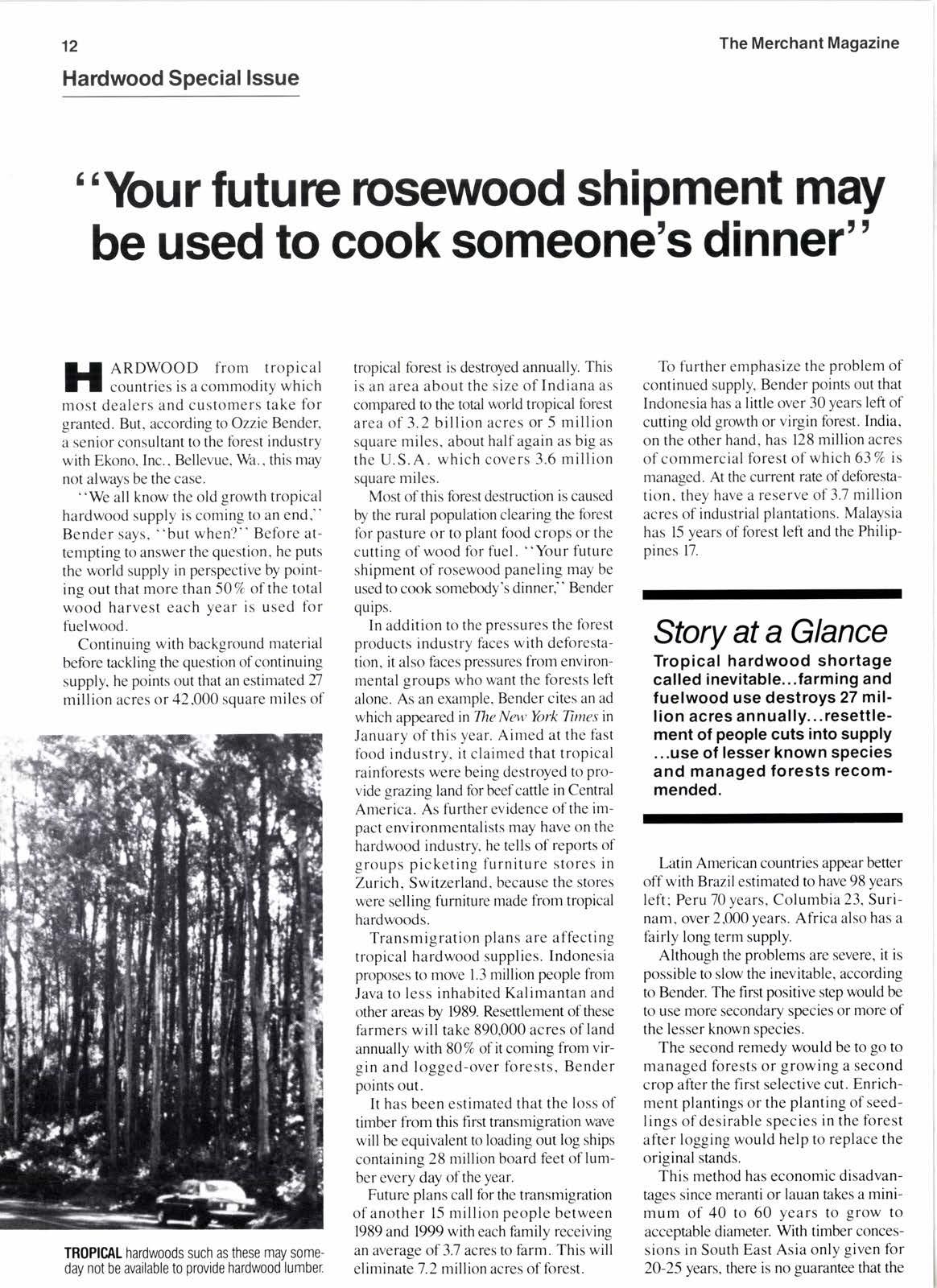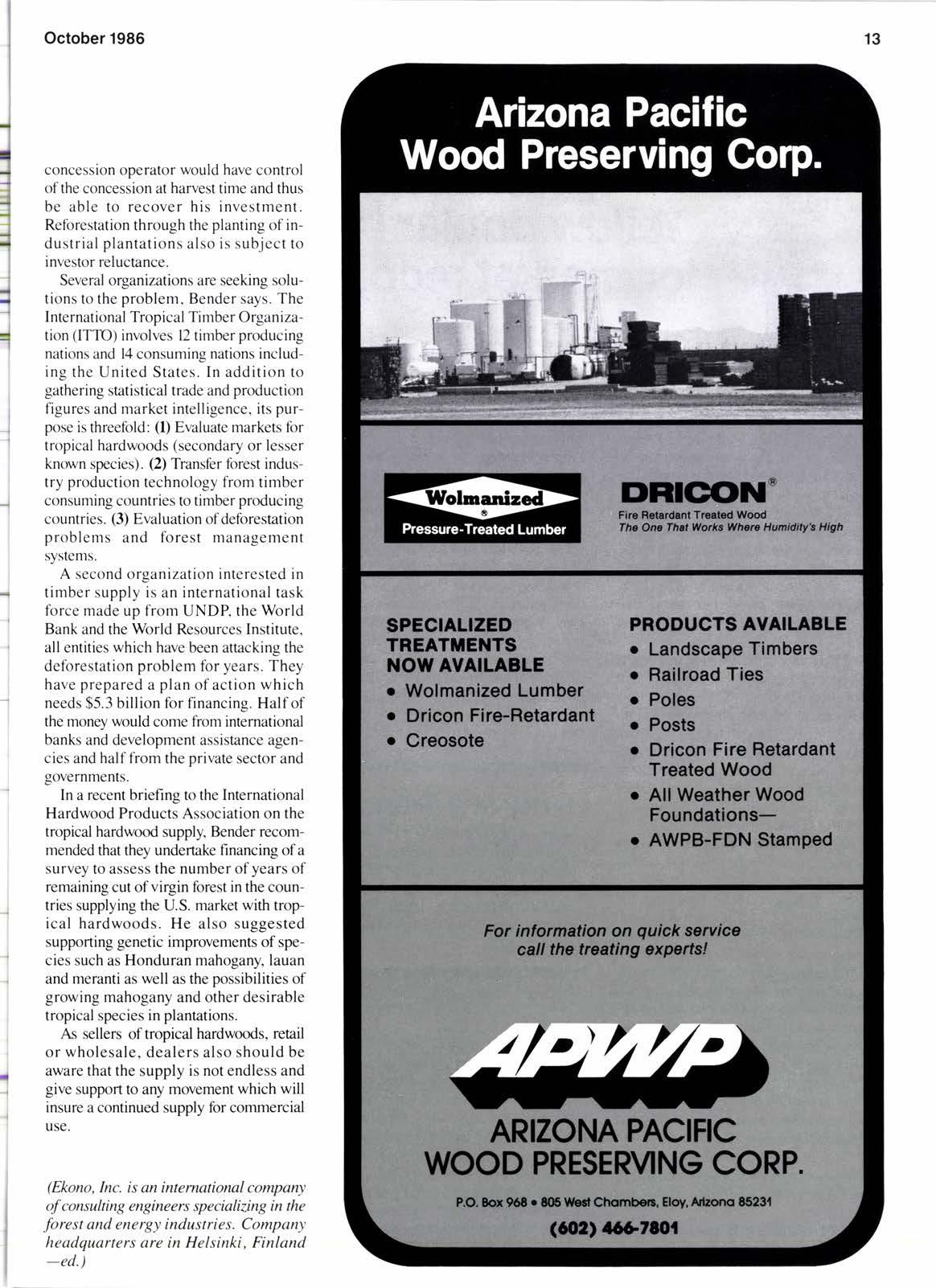
4 minute read
"Yourfuture rcsewood shipment maY be used to cook someone's dinner"
ARDWOOD from tropical countries is a commodity which most dealers and customers take for granted. But, according toOzzie Bender, a senior consultant to the forest industry with Ekono, Inc., Bellevue, Wa., this may not always be the case.
"We all know the old growth tropical hardwood supply is coming to an end," Bender says, "but when?" Before attempting to answer the question, he puts the world supply in perspective by pointing out that more than 507o of the total wood harvest each year is used for fuelwood.
Continuing with background material before tackling the question ofcontinuing supply, he points out that an estimated Z million acres or 42900 square miles of tropical forest is destroyed annually. This is an area about the size of Indiana as compared to the total world tropical forest area of 3.2 billion acres or 5 million square miles, about half again as big as the U.S.A. which covers 3.6 million square miles.
Most of this forest destruction is caused by the rural population clearing the forest for pasture or to plant food crops or the cutting of wood for fuel . "Your future shipment of rosewood paneling may be used to cook somebody's dinner," Bender qurps.
In addition to the pressures the forest products industry faces with deforestation, it also faces pressures from environmental groups who want the forests left alone. As an example, Bender cites an ad which appeared in The New' York Ttmes in January of this year. Aimed at the fast food industry, it claimed that tropical rainforests were being destroyed to provide grazing land for beef caftle in Central America. As further evidence of the impact environmentalists may have on the hardwood industry, he tells ofreports of groups picketing furniture stores in Zurich, Switzerland, because the stores were selling furniture made from tropical hardwoods.
Transmigration plans are affecting tropical hardwood supplies. Indonesia proposes to move 1.3 million people from Java to less inhabited Kalimantan and other areas by 1989. Reseftlement ofthese farmers will take 890.000 acres of land annually with 80% of it coming from virgin and logged-over forests, Bender points out.
It has been estimated that the loss of timber from this first transmigration wave will be equivalent to loading out log ships containing 28 million board feet of lumber every day ofthe year.
Future plans call lor the transmigration of another 15 million people between 1989 and 1999 with each family receiving an average of 3.7 acres to farm. This will eliminate 7.2 million acres of forest.
To further emphasize the problem of continued supply, Bender points out that Indonesia has a little over 30 years left of cutting old growth or virgin forest. India, on the other hand, has 128 million acres of commercial forest of which 63% is managed. At the current rate of deforestation, they have a reserve of 3.7 million acres of industrial plantations. Malaysia has 15 years offorest left and the Philippines 17.
Story at a Glance
Tropical hardwood shortage called inevitable...farming and fuelwood use destroys 27 million acres annually...resettlement of people cuts into supply ...use of lesser known species and managed forests recommended.
Latin American countries appear bener off with Brazil estimated to have 98 years left; Peru 70 years, Columbia 23, Surinam, over 2,000 years. Africa also has a fairly long term supply.
Although the problems are severe. it is possible to slow the inevitable, according to Bender. The first positive step would be to use more secondary species or more of the lesser known species.
The second remedy would be to go to managed forests or growing a second crop after the first selective cut. Enrichment plantings or the planting of seedlings ofdesirable species in the forest after logging would help to replace the original stands.
This method has economic disadvantages since meranti or lauan takes a minimum of 40 to 60 years to grow to acceptable diameter. With timber concessions in South East Asia only given for 2O-25 years, there is no guarantee that the conccssion opcflt()f r"oulcl har c c()ntrol ol the conccssion ut hurvest tinrc uncl thus b.' .rltl. lr) fcL()\t'r' hts tnrL'\tl)lLnt. Rclirrcstation throLrsh thc plantinu ol'industrill plantations also is sub.jcct to in\ c\tor rcluctancc.
Scr cnrl ()r ganizatr()ns lrrc sccking solutions lo the problcnr. []cndcr sur s. Thc Internat ionul TropicaI'l'inrber ()rgartizatron (t'l'l'O) nlolrcs ll tinrhcr prorlue rnu nations ancl lJ conslrnrrng nations inclutling thc []nrtctl Statcs. In udclition trr gathcring stutistical tntlc untl prodr.rctron IrItr|c: irr)(l r)ritIkr't irrt.lIi..err.t'. it' IrLrr posc is thrce lold. (l) Erllultc nrarkcts Ii)r lropical harrlwoocls (sccontlarv or lcsscr krtoun spccics). (2) TrnnslL'r lirrcst intlLrs t ry protluction tcchnologr 1l-our trrrbcr consunting coLrntrrcs to tinrtrcl producinl eountrics. (3) F-ruluation ol'rlelirrcslation problcnrs antl lirrest rrurna!lenrcnt s\ stcnls.
A sccond or!lurtization intcrcstcd in tinrbcr supplr rs an rnternational task tirrcc nlrdc up lrorn UNDP. thc Wrrrlcl Bank und thc Wrrr-ltl Rcsourccs Instrtr-rtc. all cntitics 'ui'hich havc been attackins the dclirre stution problcnr tirr I curs. 'l'hct har c pr.cparcd a plln of action u'hich needs S-5.3 billion lirr l'inancing. Hall'of the nroncv urluld corrrc lionr intcrnutional hltnkr lttt,l ([\CIdPII)clll ir)\i\lJrlL(' il:]('r) cics antl hlrll lronr thc privatc scctor-untl go\ ernntcnts.
In a rcccnt briefing to thc Internationll Hardwood Products Association on thc tropical hardr,,txrd suppll. Bcnder rcc()n) nrcnded that thcr undcrtakc lrnancing ol'a sur\e\ to asscss the nunrbcr ofyears rtt' rcnraining cut ol'virsin tirrcst in thc coun tr.ics supph inu thc U.S. nlrlkct u ith tropical hardr',oocls. He also suggcstcrl sLrpporlint gcne tic inrprovcrlcnts of spccics such as Honduran mah()gan\'. lauan ancl nrcranti as wcll as the possibilities ot' glolving nrahogunv and othcr desirablc tropir':rl spet icr itt pllrntatiotts.
As scllcrs ol'tropical hardu<xxls. rctiiil or wholcsale. clcalcrs also should be au'arc that the supplv is not t-ntllcss and siYc support to an\ nrovcnrent ilhich will insurc a continucd supply lor cornnrcrcial use.
(Ektrto, lttt. i.s tnt irtlcnttilionul c()ntl)utr\'
For information on quick:.,8srvice call the tre,aling experts!











